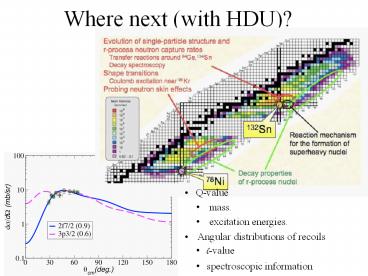Where next (with HDU)? PowerPoint PPT Presentation
Title: Where next (with HDU)?
1
Where next (with HDU)?
- Q-value
- mass.
- excitation energies.
- Angular distributions of recoils
- l-value
- spectroscopic information
2
Transfer reaction toolbox
Reaction Study Equipment
(d,p) (d,n) (d,t) neutron particle proton particle neutron hole silicon array (S-ORRUBA, SIDAR) neutron array (VANDLE) silicon array (S-ORRUBA, SIDAR)
(3He,d) (3He,n) (3He,t) proton particle 2-proton transfer charge-exchange silicon array (S-ORRUBA, SIDAR) neutron array (VANDLE) silicon array (S-ORRUBA, SIDAR) gas jet or implanted targets
(9Be,8Be) (13C,12C) neutron particle states with higher l charged particle (HI Ball) ? detection (CLARION/GRETINA)
(t,p) (10Be,8Be) 2-neutron transfer tritium target silicon array (S-ORRUBA, SIDAR)
3
Where next
- Beyond 132Sn
- 134Sn, 136Te etc..
- Proton states with (d,n).
- 2-neutron transfer (t,p)? (10Be,8Be)?
- Beyond N50
- 84Ge, 86Se etc..
- New regions
- 70Ni region.
- both neutron and proton single-particle states.
- batch mode beams of 44Ti, 56Ni, 59Fe.
4
What is needed for a successful nuclear reaction
program? (the theorists wish)
- data for several channels (elastic, inelastic)
- range of energies (low versus high)
- more theory
Optical potentials are an essential input to
calculations
should we not be working toward a CH89_ri and
BG_ri?
- nucleon elastic scattering of rare
isotopes at least (p,p) then theory for (n,n)
(?) - heavy ion elastic scattering of rare
isotopes
Other things that can help elastic elastic
breakup inelastic breakup (p,d)
reaction models need to incorporate the structure
should we be using standard radius and
diffuseness?
by probing different energies we get a glimpse
into different parts of the structure we are
interested
should we be using Hartree Fock densities, radii,
etc for unstable nuclei? (often unable to even
predict the correct bound state)
by probing different energies we can test whether
our simplified structure assumptions are correct
- need accurate description of the reaction
- better control over uncertainties in inputs
- improved understanding of reaction dynamics
- keeping contact with underlying many body
structure
5
134Te(d,p)135Te
PRELIMINARY
1 MeV (p1/2)
0.66 MeV (p3/2)
1.8 MeV (f5/2 ?)
g.s. (f7/2)
Counts
Q value (MeV)
6
Super ORRUBA
Energy-dependent lengths and high thresholds
Position-dependent gains
- Funding received Sept. 2009.
- Detectors ordered Nov. 2009.
- Design done by June 2010.
- Prototype arrive Dec. 2010.
- Full order June 2011.
- Full array June 2012.
- 512 channel system ordered 2008
- 512 channel system implemented June 2010.
- 2056 channel system implemented June 2011.
7
TIARA Performance
Only core signals from EXOGAM clovers, limiting
Doppler correction to 65 keV broadening
g
p
8
TIARA Performance
Only core signals from EXOGAM clovers, limiting
Doppler correction to 65 keV broadening
g
p
9
Principle of operation
Measured quantities Flight time
TflightTcyc Position z Energy Elab
Derived quantities Part. ID m/q Energy Ecm An
gle qcm
B2T
Particle Tcyc (ns)
p 34.2
3He2 51.4
d, a 68.5
t 102.7
10
136Xe(d,p) online spectrum B.Kay, Nov. 2009
Preliminary
11
(No Transcript)
12
(No Transcript)
13
(d,n) and b-delayed neutrons with VANDLE
- Optimize efficiency for 60 to 180 for ejected
neutrons. - 150 keV gt En gt 15 MeV
- 1.5 meter flight-path for large bars cover
central angles. - Shorter path for small bars cover lower energy
neutrons at back angles.
- Intend to measure 25Al(d,n)
- Astrophysically important 26Al possibly created
by - 25Al (p,?)?26Si(ß) ?26Al
- rp-process waiting point nuclei
- 56Ni(d,n)

